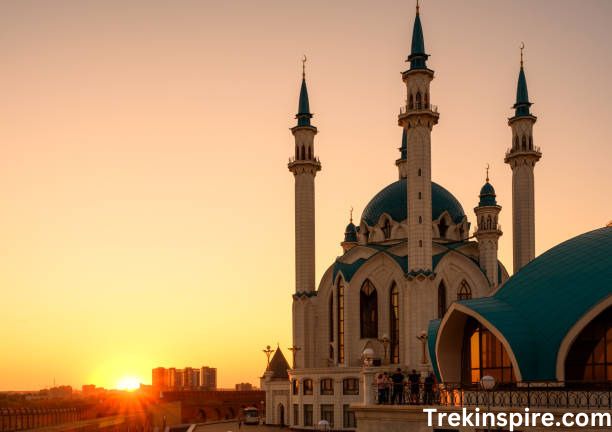Al-Hamra Mosque- All need to know
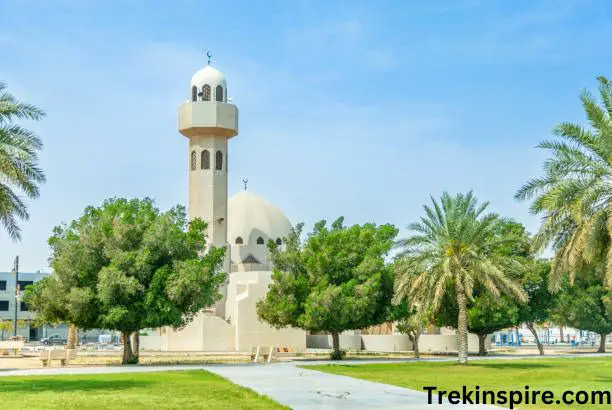
The Al-Hamra Mosque, also known as the Red Mosque, is a Marinid-era mosque in Fes, Morocco. It is a local Friday mosque located on the Grande Rue (“Great Street”) of Fes el-Jdid, the palace city founded by the Marinid rulers.
The main prayer hall is a large, domed space with a central mihrab and minbar. The mihrab decorated with intricate mosaics and carvings, while the minbar is made of carved wood. The prayer hall is also home to a number of other decorative features, including carved stucco, glazed tiles, and marble columns.
Here are some additional details about the mosque:
- The mosque is approximately 120 meters long and 70 meters wide.
- The main prayer hall can accommodate up to 20,000 people.
- The mosque has two minarets, one of which is 60 meters tall.
The Al-Hamra Mosque is one of the most important religious and cultural landmarks in Fes. It is a popular tourist destination and is also use for religious services and events.
History of Al-Hamra Mosque in Fes, Morocco
The Al-Hamra Mosque, also known as the Red Mosque, is a magnificent example of Marinid-era architecture in Fes, Morocco. Its imposing red-brick exterior and intricate interior design have made it a landmark of the city for centuries. Here’s a glimpse into the history of this iconic mosque:
Construction and Early Years:
- While the exact date of construction remains unknown, the Al-Hamra Mosque is believed to have been built in the 13th century during the reign of Marinid sultan Abu Yusuf Yaqub.
- The mosque’s name, “Al-Hamra,” translates to “The Red”, referencing its distinctive red-brick exterior constructed from local clay. This color was often used in Marinid architecture and served as a symbol of power and royalty.
- The mosque was built as a local Friday mosque, meaning it was the primary place of worship for the community and used for Friday prayers. Read Discover the Spiritual Harmony in Mosques Laval
Cultural Significance and Tourism:
- The Al-Hamra Mosque stands as a testament to the rich heritage of Islamic architecture in Fes. It serves as a place of worship for the community and a symbol of the city’s cultural identity.
- The mosque is a popular tourist destination, attracting visitors from around the world who marvel at its architectural beauty and historical significance.
- In 1981, the Al-Hamra Mosque was inscribed as a UNESCO World Heritage Site as part of the Medina of Fez. This recognition further highlights the mosque’s importance as a cultural landmark and treasure of Moroccan heritage.
Who is the founder of Al-Hamra Mosque?
Unfortunately, the exact founder of the Al-Hamra Mosque is not definitively known. There are two main theories about who it might be:
1. Sultan Abu Yusuf Yaqub: This theory is based on historical sources and architectural similarities. The Al-Hamra Mosque’s construction style aligns with other buildings known to be commissioned by Abu Yusuf Yaqub during his reign in the 13th century.
2. Sultan Abu al-Hasan: This theory is based on the architectural similarities between the Al-Hamra Mosque and the Sidi Boumediene Mosque in Tlemcen, Algeria. Both mosques were built around the same time and share many design elements. Georges Marçais, a renowned French architect and historian, proposed that the same architect built both mosques under the same ruler, suggesting Abu al-Hasan as the possible founder of the Al-Hamra Mosque.
Though the founder’s identity remains uncertain, both Abu Yusuf Yaqub and Abu al-Hasan were powerful rulers who played significant roles in shaping the architectural landscape of the Marinid dynasty. The Al-Hamra Mosque stands as a testament to their contributions to Islamic art architecture.
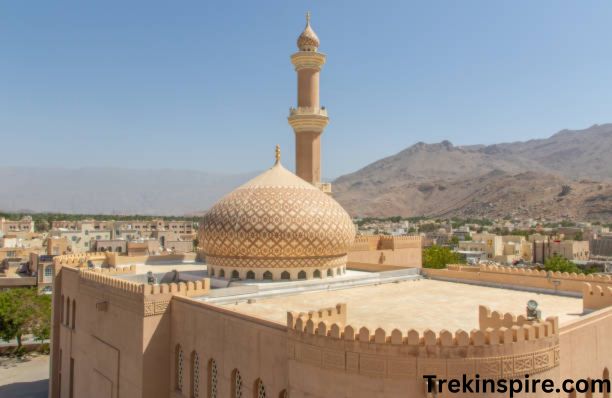
Architecture of the Al-Hamra Mosque, Fes, Morocco
The Al-Hamra Mosque, known for its striking red-brick exterior, showcases a unique blend of architectural styles and features that reflect its Marinid-era construction. Here’s a closer look at its key architectural elements:
Overall Layout:
- Rectangular floor plan: The mosque follows a rectangular layout, with a spacious courtyard (sahn) occupying the northern part.
- Courtyard (Sahn): Surrounded by arcaded galleries on three sides, the sahn provides a shaded, open space for prayer and contemplation.
- Main Prayer Hall: Positioned on the south side of the sahn, the main prayer hall is a vast, domed space.
Key Architectural Features:
- Red Brick Exterior: The most striking feature is the red-brick exterior, constructed from local clay. Red was a favored color in Marinid architecture and symbolized power and royalty.
- Arcades: Elegant arcades line the courtyard and the interior walls, creating a sense of rhythm and openness.
- Mihrab: The central mihrab, a niche indicating the direction of prayer towards Mecca, is a masterpiece of craftsmanship. It’s adorned with intricate mosaics and carvings, showcasing geometric patterns and arabesque designs.
- Minbar: The finely carved wooden minbar, a raised platform used for delivering sermons, adds to the decorative richness of the interior.
- Domes: The main prayer hall crowned by a magnificent dome, showcasing intricate geometric patterns and highlighting the architectural prowess of the Marinid era.
- Muqarnas: The transition from the dome to the square space below adorned with muqarnas, a type of honeycomb-like ornamentation, that adds depth and visual interest.
- Stucco Decorations: Walls throughout the mosque adorned with elaborate stucco-carved decorations, featuring geometric motifs, arabesque patterns, and calligraphic inscriptions.
- Glazed Tiles: The use of colorful glazed tiles adds vibrant accents and contributes to the overall decorative scheme.
- Marble Columns: Slender marble columns add a touch of elegance to the interior and support the arches and arcades. Read Chehalis Lake -British Columbia, Canada
Influences and Architectural Style:
- Marinid Architecture: The mosque reflects the characteristic features of Marinid architecture, known for its geometric patterns, intricate decorations, and use of red brick.
- Almohad Influence: While primarily Marinid in style, the mosque also exhibits some influences from the preceding Almohad period, particularly in the layout and overall design.
- Nasrid Connection: The architecture shares similarities with the iconic Alhambra palace in Granada, Spain, reflecting the cultural and artistic exchange between the Marinid and Nasrid dynasties.
Significance:
The architecture of the Al-Hamra Mosque embodies the artistic and technological achievements of the Marinid era. It serves as a testament to the sophistication and creativity of Moroccan architects and craftsmen and continues to inspire awe and admiration through its intricate details and architectural grandeur.
Islamic Calligraphy at Al-Hamra
The Al-Hamra Mosque showcases various styles of Islamic calligraphy, each with its unique characteristics:
- Kufic script: This angular script, with its bold, geometric strokes, is the oldest form of Islamic calligraphy and is often used for inscriptions on religious buildings.
- Naskh script: This elegant and legible script is widely use for Qur’anic transcriptions and religious texts. Its flowing lines and clear letterforms make it easy to read and recite.
- Thuluth script: This majestic script features elongated vertical strokes and flourishes, creating a decorative and imposing effect. It is also often use for headings and titles in manuscripts and inscriptions.
- Muhaqqaq script: This script is characterized by its large letterforms and bold strokes, making it particularly suited for monumental inscriptions. Its balanced composition and rhythmic flow enhance the beauty of the architectural elements.
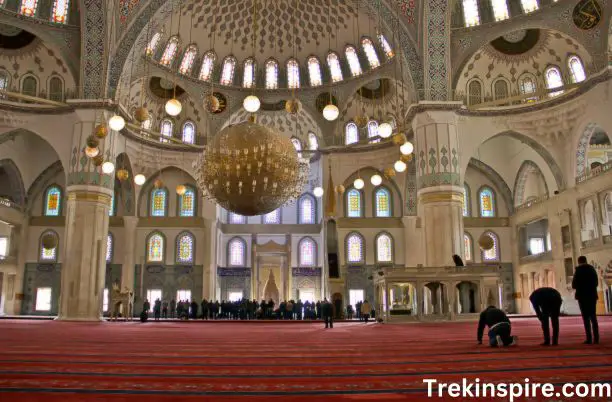
Locations of Calligraphy:
The calligraphic inscriptions at the Al-Hamra Mosque are strategically place to enhance the spiritual atmosphere and convey religious messages:
- Mihrab: The mihrab, the niche indicating the direction of prayer, features intricate calligraphy praising Allah and the Prophet Muhammad.
- Walls: The walls throughout the mosque decorate with calligraphic panels containing verses from the Quran, hadiths (sayings of the Prophet), and also religious invocations.
- Ceilings: The ceilings in certain areas display calligraphic designs, adding a layer of artistic complexity to the architectural space.
Significance of Calligraphy:
The Islamic calligraphy at the Al-Hamra Mosque goes beyond mere decoration. It also serves multiple purposes:
- Religious expression: The calligraphic inscriptions convey religious messages and teachings, reminding worshippers of their faith and guiding them towards spiritual reflection.
- Artistic beauty: The intricate calligraphy adds to the aesthetic appeal of the mosque, creating a sense of awe and wonder.
- Cultural heritage: The calligraphy showcases the rich artistic tradition of Islamic art and calligraphy, preserving it for future generations.
- Historical record: The inscriptions can provide valuable information about the mosque’s construction date, patrons, and the cultural context of the time.
Al-Hamra’s Religious Practices
The Al-Hamra Mosque in Fes, Morocco, serves as a vibrant center of religious practice for the Muslim community. Beyond its architectural splendor, the mosque fosters a rich tapestry of traditions and also rituals that guide the lives of its worshippers. Let’s delve into the heart of Al-Hamra’s religious practices: Read Rice Lake in North Vancouver
1. Daily Prayers:
- Five Daily Prayers: The Al-Hamra Mosque echoes with the collective recitation of prayers five times a day: Fajr (dawn), Zuhr (noon), Asr (afternoon), Maghrib (sunset), and Isha (night).
- Adhan (Call to Prayer): The melodic call to prayer, resonating from the mosque’s minaret, summons worshippers to join the congregation and also fulfill their religious duty.
- Congregation: Muslims gather within the spacious prayer hall, aligning themselves towards the mihrab, a niche that also indicates the direction of Mecca.
2. Friday Prayers:
- Jumu’ah: Every Friday, the mosque witnesses a larger gathering for the special Friday prayers. This obligatory service includes a sermon delivered by the Imam, followed by prayers and supplications.
- Importance: Friday prayers hold significant religious and social importance, fostering community spirit and reminding believers of their collective responsibility.
3. Ramadan and Eid:
- Ramadan: During the holy month of Ramadan, the mosque transforms into a hub of increased piety and devotion. Muslims observe fasting from dawn to dusk, attending special night prayers (Taraweeh) and engaging in Quranic recitation.
- Eid al-Fitr and Eid al-Adha: The joyous celebrations of Eid al-Fitr and Eid al-Adha mark the culmination of Ramadan and the Hajj pilgrimage, respectively. The mosque also vibrates with festive energy as worshippers gather for Eid prayers and exchange greetings.
4. Quranic Recitation and Learning:
- Tahfidh: The mosque provides opportunities for individuals to learn and memorize the Quran, a practice known as Tahfidh.
- Spiritual Guidance: Visitors seeking religious guidance can consult with Imams and scholars at the mosque, receiving advice and support on various religious matters.
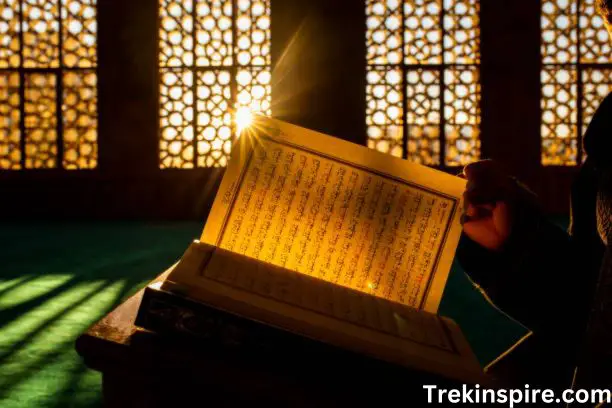
Events at Al-Hamra Mosque, in Fes, Morocco
While the Al-Hamra Mosque primarily serves as a place of worship and religious learning, there are a variety of events that take place within its walls or surrounding area. Here’s an overview of the types of events you might encounter at the Al-Hamra Mosque:
Religious Events:
- Friday Prayers: Every Friday, the mosque would have hosted the main congregational prayer for the community. Imams would lead the prayers and deliver sermons, fostering a sense of unity and religious practice.
- Ramadan Observances: During the holy month of Ramadan, the mosque would be a central hub for increased prayer, recitation of the Quran, and spiritual reflection. Special nightly prayers called Tarawih would be held, attracting large gatherings of worshippers.
- Festival Celebrations: Religious festivals like Eid al-Fitr and Eid al-Adha would also be celebrate with special prayers and festivities at the mosque, fostering a sense of community and joy.
Educational Events:
- Quranic Studies: The mosque would likely have been a center for Quranic recitation and learning. Scholars and teachers would lead sessions where students memorized and studied the Quran, deepening their understanding of Islamic scripture.
- Religious Lectures: Renowned scholars and religious figures might have delivered lectures and sermons at the mosque, providing spiritual guidance and insights to the community.
- Calligraphy and Arabic Language Classes: The mosque could have been a space for learning calligraphy, the art of writing Arabic script beautifully, and for developing proficiency in the Arabic language, essential for religious study and cultural understanding. Read Mahon Park – North Vancouver, British Columbia
Historical Events:
- Marinid Dynasty: The construction of the Al-Hamra Mosque in the 13th century coincided with the reign of the Marinid dynasty, a period of cultural and political flourishing in Morocco. The mosque can be seen as a testament to the Marinid’s architectural achievements and power.
- French Protectorate: During the French protectorate of Morocco (1912-1956), the Al-Hamra Mosque served as a symbol of resistance and cultural identity for the Moroccan people. It became a focal point for demonstrations and gatherings against French rule.
- Independence Movement: The mosque played a role in the Moroccan independence movement, with nationalist leaders often giving speeches or holding meetings within its walls.
Cultural Events:
- Fes Festival of World Sacred Music: Held annually in Fes, this renowned festival often incorporates the Al-Hamra Mosque as a venue for concerts and performances featuring spiritual music from various traditions.
- Sufi Music and Poetry Recitals: The mosque has hosted traditional Sufi music and poetry recitals, offering a unique cultural experience for visitors and locals.
- Crafts and Souk Activity: The bustling souk (marketplace) surrounding the Al-Hamra Mosque is a hive of activity and cultural exchange, showcasing Moroccan crafts and traditions.
Other popular mosques in Fes, Morocco
Fes, Morocco, boasts a rich tradition of Islamic architecture, with numerous mosques captivating visitors with their unique styles and histories. Here are some other popular mosques in Fes, alongside the Al-Hamra Mosque:
1. Kairaouine Mosque (Mosque of al-Qarawiyyin):
- Considered the oldest continuously operating university in the world, established in 859 AD by Fatima al-Fihri.
- Renowned for its vast prayer hall, intricate mosaics, and towering minaret.
- Attracts large congregations for daily prayers and special occasions like Ramadan and Eid.
2. Bou Inania Madrasa:
- This 14th-century madrasa (religious school) is renowned for its exquisite zellij (mosaic tilework) and intricate wood carvings.
- Features a mesmerizing central courtyard with a fountain and surrounding galleries.
- Offers a glimpse into the traditional architectural style of Marinid madrasas.
3. Attarine Madrasa:
- Located in the heart of the Fes el-Bali medina, this 14th-century madrasa boasts stunning geometric patterns and arabesque decorations.
- Features a beautiful courtyard with a central fountain and four iwans (arched halls).
- Houses a museum showcasing Islamic art and artifacts.
4. Chrabliyine Mosque:
- This charming 19th-century mosque is known for its vibrant green tilework and unique horseshoe-shaped arches.
- Offers a tranquil atmosphere and a picturesque setting within the medina.
- Popular among locals and tourists alike for its peaceful ambiance.
5. Sidi Ahmed Tijani Zawiya:
- This zawiya (religious complex) is dedicated to the founder of the Tijaniyya Sufi order.
- Features a beautiful courtyard, a mausoleum, and a library containing Sufi manuscripts.
- Serves as a pilgrimage site for Tijani followers and offers a glimpse into Sufi practices.
These are just a few of the many remarkable mosques in Fes, Morocco. Each one possesses its unique charm and historical significance, offering visitors a diverse perspective on Islamic art and architecture. Read Kirkmans Cove Lake
